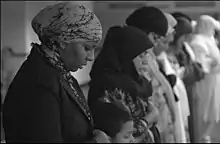Salah
Salah (Arabic: صَلَاة, plural salawat, romanized: Arabic pronunciation: [sˤaˈla] or Old Arabic [t͡sˤaˈloːh], ([sˤaˈlaːt] or Old Arabic [t͡sˤaˈloːtʰ] in construct state) lit. 'prayer'),[1] also known as namāz (Persian: نماز), is worship performed by Muslims. Facing the qibla, the direction of the Kaaba with respect to those praying, Muslims pray first standing and later kneeling or sitting on the ground, reciting prescribed prayers and phrases from the Quran as they bow and prostrate themselves in between.
| Salah | |
|---|---|
.jpg.webp) Muslims doing ruku (bowing) during a prayer at a mosque | |
| Official name | صلاة |
| Also called | Prayer in Islam |
| Observed by | Muslims |
| Type | Islamic |
| Significance | Muslim prayer offered to God according to legal jurisprudence |
| Observances | |
| Related to | Tilawa, ruku, sujud |
| Part of a series on |
| Islam |
|---|
 |
| Part of a series on Aqidah |
|---|
 |
|
Including:
|
Salah is composed of prescribed repetitive cycles of bows and prostrations, called rakat (sing. rak'ah). The number of rak'ahs, also known as units of prayer, varies from prayer to prayer. Ritual purity and wudu are prerequisites for performing the prayers.[2][3][4] Salah can be performed either in solitude, or collectively (known as jama'ah). When performed in jama'ah, worshippers line up in parallel rows behind a leader, known as the Imam ("leader"). Special prayers are exclusively performed in congregation, such as the Friday prayer and the Eid prayers, and may be coupled with two sermons each, delivered by the Imam.[2]
The daily obligatory prayers collectively form the second of the five pillars in Islam, observed three[5][6] or five times (the latter being the majority) every day at prescribed times. These are usually Fajr (observed at dawn), Zuhr (observed at noon), Asr (observed late in the afternoon), Maghrib (observed after sunset), and Isha (observed at dusk).
Etymology
Ṣalāh ([sˤaˈla] صلاة) is an Arabic word that means to pray.[7] The word is used primarily by English speakers only to refer to the five obligatory prayers of Islam. This term is spelled as solat in Malaysia, Brunei and Indonesia, salaad in Somalia, and swalah in Tanzania and by other Swahili speakers.
The origin of the word salah has become a matter of debate, particularly in relation to Quranism. Some have suggested that salah derives from the root و ص ل (w-ṣ-l) which means "linking things together",[8] hence why the obligatory prayers in Islam are referred to by the word salah (in the sense that through prayer one "connects" to God). In some translations, namely that of Rashad Khalifa, salah is translated as the "Contact Prayer"[9] either because of the physical contact the head makes with the ground during the prostration part of the ritual (sujud), or again because the prayer "connects" the one who performs it to God. Other sources claim that the root is in fact ص ل و (s-l-w) the ultimate meaning of which is not agreed upon.[10]
Salah is thought to come from the Classical Syriac word ܨܠܘܬ (ṣəlōṯ) meaning prayer, temple, sanctuary or the theological idea of reconciliation in Christianity. Səlōṯ itself is believed to derive from the root ܨ-ܠ-ܐ (ṣ-l-ʾ) which is related to bending or bowing down.
Some Quranists make the argument that the Quran does not support the traditional meaning ascribed to salah, saying that it instead means "duty" or perhaps "adherence", though this is yet to receive any widespread academic support. Those who argue for this interpretation often refer to verse 33:56 of the Quran which states that "Allah and His Angels yuṣallūna upon the Prophet". They argue that such verses demonstrate the conventional understanding of salah to be inconsistent and in this case blasphemous as the idea of Allah praying to Muhammad (or indeed praying at all) is at odds with the Quran's message of strict monotheism.
Namaz
Namāz (Persian: نماز) is the Persian name of salah, originating from ancient Middle Persian language meaning "reverence". It is the term presently used in Turkey and other Turkic-language nations such as Kazakhstan (Kazakh: Намаз), in Bosnia, in Iran, Afghanistan, Tajikistan and other Persianate languages of the Indian subcontinent such as Urdu (Hindi: नमाज़) and Bengali (Bengali: নামাজ).[11]
In the Quran
The noun ṣalā (صلاة) is used 83 times in the Quran.[12][13]
There are about 15 other derivatives of the semitic root ṣ-l.[12] Words connected to sala (such as mosque, wudu, dhikr, etc.) are used in approximately one-sixth of Quranic verses.[14] "Surely my prayer, and my sacrifice and my life and my death are (all) for God",[15][lower-alpha 1] and "I am Allah, there is no god but I, therefore serve Me and keep up prayer for My remembrance"[16][lower-alpha 2] are both examples of this.
Religious significance

The primary purpose of salah is to act as a person's communication with God.[17] Purification of the heart is the ultimate religious objective of salah. Via salah, a believer can grow closer to Allah and in turn strengthen their faith; it is believed that the soul requires prayer and closeness to Allah to stay sustained and healthy, and that prayer spiritually sustains the human soul.[18]
Tafsir (exegesis) of the Quran can give four reasons for the observation of salah. First, in order to commend God, God's servants, together with the angels, do salah ("blessing, salutations").[19][lower-alpha 3] Second, salah is done involuntarily by all beings in creation, in the sense that they are always in contact with God by virtue of him creating and sustaining them.[20][lower-alpha 4] Third, Muslims voluntarily offer salah to reveal that it is the particular form of worship that belongs to the prophets.[lower-alpha 5] Fourth, salah is described as the second pillar of Islam.[7]
Procedure

Each salah is made up of repeating units known as rakat (Arabic: رَكَعَات, sing. rak'ah). Each prayer may consist of two to four rakat. Each rak'ah consists of specific movements and recitations. On the major elements there is consensus, but on minor details there may be different views. Between each position there is a very slight pause. The phrase Allahu akbar (takbir), is recited when moving from one position to another, except from rukū' to qiyām.
Beginning
Before prayer, a Muslim should always perform wudu, an act in which the hands are first washed, the mouth and nose are cleaned, the face is cleaned, the arms up to the elbow are washed, and the head is wiped over with wet hands, including the ears, before finally the feet are washed. Intention, known as niyyah, is a prerequisite for salah, and what distinguishes worship from 'going through the motions'. Some authorities hold that intention suffices in the heart, and some require that it be spoken, usually under the breath.[21]
The person praying begins in a standing position known as qiyam, although people who find it difficult to do so may begin while sitting or lying on the ground.[7] This is followed by the raising of the hands to the head and recitation of the takbīr, known in combination as takbīrat al-iḥrām or takbīrat at-taḥrīmah (consecratory takbīr). Takbīr is read as Allaahu Akbar (lit. 'God is The Greatest'). One then lowers one's hands. The first takbīr represents the beginning of prayer. From this point forward one praying may not converse, eat, or do things that are otherwise halal. A Muslim must keep their vision low during prayer, looking at the place where their face will contact the ground during prostration.[21][22][23]
Common elements of each rakat
Still standing, the next principal act is the recitation of Al-Fatiha, the first chapter of the Quran. This chapter begins with praise of God and then a supplication is made to God. In the first and second rakat, another portion of the Quran is recited following the Fatiha. This is followed by saying Allaahu Akbar and raising the hands up to the ear lobes (rafah yadain) followed by rakooh (bowing from the waist), with palms placed on the knees (depending on the madhhab, rules may differ for women). While bowing, those praying generally utter words of praise under their breath, such as سبحان ربي العظيم (lit. 'Glory be to my Lord, the Most Magnificent'), thrice or more. As the worshipper straightens their back, they say سمع الله لمن حمده (lit. 'God hears the one who praises him') and ربنا لك الحمد (rabbanā laka l-ḥamd, "Our Lord, all praise be to you.")[21]

This is followed by saying Allaahu Akbar and raising the hands up to the ear lobes, before the worshipper kneels and prostrates with the forehead, nose, knees, palms and toes touching the floor, saying سبحان ربى الأعلى (lit. 'Glory be to my Lord, the Most High'). After a short while in prostration, the worshipper very briefly rises to sit, then returns to the ground a second time. Lifting the head from the second prostration completes a rak'ah. If this is the second or last raka'ah, the worshiper proceeds to sit and recite the tashahhud, salawat and other prayers.[21] Many schools hold that the right index finger is raised when reciting the salawat,[21] particularly the Sunni school scholars who adapted the technical practice of prayer found in the hadith of Zubayr ibn al-Awwam, as transmitted by Muslim ibn al-Hajjaj. In the final phase of az-Zubayr's practice, the middle, ring, and pinky fingers on the right hand are clasped, while the index finger is pointed and the thumb placed above the clasped middle finger.[Notes 1] This practice of az-Zubayr's became a basis principle by modern scholars such as Muhammad ibn Abd al-Wahhab in his book, Adab al-Mashy Ila as-Salaa,[25] and Muhammad Nasiruddin al-Albani.[26] If the worshipper then intends to finish their prayer, they perform the taslim, or continue with a new rak'ah.
Mistakes in salah are believed to be compensated for by prostrating twice at the end of the prayer, known as sujud sahwi.[27] The taslim is read as Assalamualaikum wa rahmatullah (lit. 'Peace and mercy of Allah be upon you All'). Taslim represents the end of prayer.
Taslim
Taslim (تسليم) is the concluding portion of the salah, where one recites السلام عليكم ورحمة الله As-salāmu ʿalaikum wa-raḥmatu-llah ("Peace and blessings of God be unto you")[28] once while facing the right, and once while facing the left.[29]
Performing the Taslim Reciting the salam facing the right direction Reciting the salam facing the left direction
Types of salah
Prayers in Islam are classified into categories based on degrees of obligation. One common classification is fard ("compulsory"), sunnah ("tradition") and nafl ("voluntary").[30]
Compulsory prayers
The five daily prayers are considered by many to be obligatory on every Muslim who has reached the age of puberty, with the exception of those for whom it may not be possible due to physical or mental disabilities,[31] and those menstruating (hayd) or experiencing postnatal bleeding (nifas).[32] Those who are sick or otherwise physically unable to offer their prayers in the traditional form are permitted to offer their prayers while sitting or lying, as they are able.[33] Each of the five prayers has a prescribed time, depending on the movement of the sun. These are the Fajr prayer (2 rakat, observed at dawn), Zuhr prayer (4 rakat, observed at noon), Asr prayer (4 rakat, observed late in the afternoon), Maghrib prayer (3 rakat, observed after sunset), and the Isha prayer (4 rakat, observed at nighttime). Salah must be prayed in its time. In certain circumstances, one may be unable to offer one's prayer within the prescribed time. In this case, the prayer must be offered as soon as possible. Several hadith narrate that Muhammad stated that it is permissible to pray salah out of its permissible time if a person accidentally sleeps through the prescribed time. However, knowingly sleeping through the prescribed time for Salah is deemed impermissible by most scholars.[34]

Qasr (Shortening Prayers)
When traveling over long distances, one may shorten the Zuhr, 'Asr and 'Isha'a prayers (which are normally 4 rakat) to 2 rakat, a practice known as qasr.[35]
Jam' (Combining Prayers)
In Shia Ja'fari Fiqh, one may perform jam' bayn as-salātayn, which refers to praying the Zuhr and 'Asr prayers in combination at one of its time, as well as the Maghrib and Isha'a prayers at one of its time. However, praying separately is considered better. Neither qasr nor jam' bayn as-salātayn can be applied to the Fajr prayer.[36]
Barring the Hanafites, Sunni jurisprudence also permit to combine Maghrib and 'Isha'a prayers or Dhuhr and 'Asr prayers if they are traveling and incapable of independently performing the prayers. Amongst Sunnis, Salafi Muslims allow the combining of two consecutive prayers for a wide range of reasons; such as when various needs arise or due to any difficulty.[37][38] Taking precedence from Imams of the Salaf and early Muhaddithun; many Salafis amongst the Ahl-i Hadith school permit combining two consecutive prayers generally, although praying separately is preferred.[39][40]
Sunni view
Of the fard category are the five daily prayers, as well as the Gathering prayer (Jumu'ah), while the Eid prayers and Witr are of the Wajib category.[41] Abandoning the obligatory prayers due to negligence is Kufr (disbelief) according to the stricter Hanbali madhhab of Sunni Islam, while the other Sunni madhhabs consider doing so a major sin. However, all four madhhabs agree that denial of the mandatory status of these prayers invalidates the faith of those who do so, rendering them apostates. The Islamic prophet Muhammad is reported to have said: "Between man and polytheism and unbelief is the abandonment of salat." (Sahih Muslim Book 1, hadith 154).[42]
Fard prayers (as with all fard actions) are further classed as either fard al-ayn (obligation of the self) and fard al-kifayah (obligation of sufficiency). Fard al-Ayn are actions considered obligatory on individuals, for which the individual will be held to account if the actions are neglected.[43] Fard al-Kifayah are actions considered obligatory on the Muslim community at large, so that if some people within the community carry it out no Muslim is considered blameworthy, but if no one carries it out, all incur a collective punishment.[44]
Followers of Imam Abu Hanifa also include a 6th obligatory prayer, witr. It is supposed to be the last prayer of the night and is composed of an odd number of rakat. This obligation is considered a lesser obligation to the other 5 obligatory prayers, in that its rejection is not an act of disbelief according to the Hanafi school. The other schools consider this to be a Sunnah muakkadah (emphasized sunnah).
Some Islamic scholars require men to offer the mandatory salat in congregation (jama'ah), behind an imam when they are able however, according to most Islamic scholars, prayer in congregation is mustahabb (recommended) for men, if they are able to do so.[45]
Special congregational prayers

The Jumu'ah is a congregational prayer on Friday, which replaces the Zuhr prayer. It is compulsory upon men to pray this in congregation, while women may pray it so or offer Zuhr prayer instead.[46] Jumu'ah consists of a sermon (khutbah), after which two rakats are prayed.[47] Since the khutbah replaces the two rakat of Zuhr, it is believed that listening to it carefully compensates the thawāb of 2 rakat.[48]
The salah of the 'Idayn is said on the mornings of ''Eid al-Fitr and 'Eid an-nahr. The Eid prayer is classified by some as fard, likely an individual obligation (fard al-ayn) though some Islamic scholars argue it is only a collective obligation (fard al-kifayah). It consists of two rakats, with seven (or three for the followers Imam Abu Hanifa) takbirs offered before the start of the first rakat and five (or three for the followers of Imam Abu Hanifa) before the second. After the salah is completed, a sermon (khutbah) is offered. However, the khutbah is not an integral part of the Eid salah.[49] The Eid salah must be offered between sunrise and true noon i.e. between the time periods for Fajr and Zuhr.[35]
Supererogatory prayers
Sunnah and nafl
Sunni Muslims perform optional sunnah salah (voluntary prayers offered by Muhammad) of two categories: sunnah mu'akkadah (verified sunnah) and sunnah ghair-mu'akkadah (unverified sunnah). The primary difference between the two being the frequency of Muhammad having performed the relevant salah. Certain sunnah prayers have prescribed times. Those ordained for before each of the fard prayers must be offered between the first call to prayer (adhan) and the second call (iqamah), which signifies the start of the fard prayer. Those sunnah ordained for after the fard prayers can be said any time between the end of the fard prayers and the end of the current prayer's waqt.
While Sunni Muslims classify these prayers as sunnah, Shia consider them nafl. Nafl salah are voluntary and can be offered at any time.[50] Many Sunni Muslims also offer two rakats of nafl salah after the Zuhr and Maghrib prayers. During the Isha prayer, they pray the two rakats of nafl after the two sunnah mu'akkadah and wajib prayers.[51] There are many specific conditions or situations when one may wish to offer nafl prayers. They cannot be offered at sunrise, true noon, or sunset. The prohibition against salah at these times is to prevent the practice of sun worship.[52] Some Muslims offer voluntary prayers immediately before and after the five prescribed prayers. A table of these prayers is given below.
| Compulsory (fard) prayer | Voluntary before fard[t 1] | Obligatory | Voluntary after fard[t 1] | Total | ||||
|---|---|---|---|---|---|---|---|---|
| Sunni | Shia | Sunni | Shia | Sunni | Shia | Sunni | Shia | |
| Fajr | 2 rakat¤ | 2 rakat[t 1] | 2 rakat[t 1] | None | 2 rakat[t 1] | 4 r. | 6 r. | |
| Zuhr | 4 rakat¤ | 4 rakat | 4 rakat[t 2] | 2 rakat¤[t 3] | 8 r.[t 1][t 4][t 5] | 10 r. | 16 r. | |
| Asr | 4 rakat‡ | 4 rakat | 4 rakat | None | 8 r.[t 1][t 4][t 5] | 8 r. | 16 r. | |
| Maghrib | 2 rakat | 3 rakat | 3 rakat | 2 rakat¤[t 3] | 2 r.[t 1][t 4][t 5] | 7 r. | 11 r. | |
| Isha[t 6] | 4 rakat‡ | 4 rakat | 4 r.× | 4 r. | 2 rakat¤[t 3] | 2 r.[t 1][t 4][t 5] | 10 r. | 10 r. |
| Jumu'ah | 2 rakat‡ | 2 rakat | 2 rakat with khutbah | 4 rakat¤
2 rakat¤ 2 r. nafl |
2 rakat | 14 r. | 6 r. | |
| ¤: denotes sunnah mu'akkadah (verified sunnah), which must be offered by adherents of the Hanafi madhhab.
‡: denotes sunnah ghair-mu'akkadah (unverified sunnah). ×: offered as two prayers of 4 and 3 rakat, with the 3 rakat considered wajib and performed after the 4 fard rakat. | ||||||||

Prayers of the night

Tahajjud (Arabic: تَهَجُّد) are supererogatory prayers offered late at night. Prayers of this kind are observed from midnight to the prescribed time of the Fajr prayer.[53] The prayer includes any number of even rakat, performed in twos or fours, followed by three or more odd rakat of witr prayer.[54] Shia Muslims offer similar prayers, simply called nightly prayers (Arabic: صَلَوَات اللَّيل). These are considered highly meritorious, and can be offered in the same time as tahajjud.[55][56] These prayers include eleven rakat: 8 nafl (4 prayers of 2 rakat each), 2 rakat shaf' prayer and 1 rakat witr.[56] Witr (Arabic: وِتر lit. 'string') are prayers offered either with the Isha prayer or with the tahajjud/salawat al-layl. Some consider this prayer compulsory (wajib), while others consider it supererogatory. These are performed in odd numbers of rakats, with slight differences between madhhabs. The prayer usually includes the qunūt.[55]
Other prayers
The word istikharah is derived from the root ḵ-y-r (خير) "well-being, goodness, choice, selection".[57] Salat al-Istikhaarah is a prayer offered when a Muslim needs guidance on a particular matter. To say this salah one should pray two rakats of non-obligatory salah to completion. After completion one should request God that which on is better.[35] The intention for the salah should be in one's heart to pray two rakats of salah followed by Istikhaarah. The salah can be offered at any of the times where salah is not forbidden.[58] Other prayers include the tahiyyat al-masjid, which Muslims are encouraged to offer these two rakat.[59]
Differences in practice
.jpg.webp)
Muslims believe that Muhammad practiced, taught, and disseminated the worship ritual in the whole community of Muslims and made it part of their life. The practice has, therefore, been concurrently and perpetually practiced by the community in each of the generations. The authority for the basic forms of the salah is neither the hadiths nor the Quran, but rather the consensus of Muslims.[61][62]
This is not inconsistent with another fact that Muslims have shown diversity in their practice since the earliest days of practice, so the salah practiced by one Muslim may differ from another's in minor details. In some cases the Hadith suggest some of this diversity of practice was known of and approved by Muhammad himself.[63]
Most differences arise because of different interpretations of the Islamic legal sources by the different schools of law (madhhabs) in Sunni Islam, and by different legal traditions within Shia Islam. In the case of ritual worship these differences are generally minor, and should rarely cause dispute.[64]

Common differences, which may vary between schools and gender, include the position of legs, feet, hands and fingers, where the eyes should focus, the minimum amount of recitation, the volume of recitation (audible, moving of lips, or just listening (Loud prayer, Silent prayer)), and which of the principal elements of the prayer are indispensable, versus recommended or optional.
A 2015 Pew Research Center study found that women are 2% more likely than men to pray on a daily basis.[65]
Prayer in congregation
.jpg.webp)

%252C_Dhaka%252C_Bangladesh_NK.JPG.webp)
Prayer in the congregation (jama'ah) is considered to have more social and spiritual benefits than praying by oneself.[66] As per hadith traditions, the reward of a prayer in congregation increases twenty-five times. A hadith says: "The prayer in congregation is twenty five times superior to the prayer offered by person alone." (Sahih Bukhari 646).[67]
When praying in congregation, the people stand in straight parallel rows behind one person who conducts the prayer, called imam, also called the 'leader'. The imam must be above the rest in knowledge, action, piety, and justness and possess faith and commitment the people trust, Balanced Perception of Religion and the best knowledge of the Quran.[34] The prayer is offered as normal, with the congregation following the imam in order as he/she offers the salah.[68]
Standing arrangement
For two people of the same gender, they would stand in line, the imam would stand on the left, and the other person is on the right. For more than two people, the imam stands one row ahead of the rest.
When the worshippers consist of men and women combined, a man is chosen as the imam. In this situation, women are typically forbidden from assuming this role. This point, though unanimously agreed on by the major schools of Islam, is disputed by some groups, based partly on a hadith whose interpretation is controversial. When the congregation consists entirely of women and pre-pubescent children, one woman is chosen as imam.[69] When men, women, and children are praying, the children's rows are usually between the men's and women's rows, with the men at the front and women at the back. Another configuration is where the men's and women's rows are side by side, separated by a curtain or other barrier,[70] with the primary intention being for there to be no direct line of sight between male and female Worshippers.[71]
Professed benefits
According to the Qur'an, salah prevents fahisha and forbidden acts:[72]
Recite that which has been revealed to you of the Book and keep up prayer; surely prayer keeps (one) away from indecency and evil, and certainly the remembrance of Allah is the greatest, and Allah knows what you do.
See also
References
Footnotes
- The author also noted these particular movements used by az-Zubayr were also practiced by Abdullah ibn Umar in Sahih Muslim number 1339[24]
Notes
- According to Shia Muslims, these are to be said in two and two rakats (four in total). This is not the case for Sunni Muslims.
- Replaced by Jumu'ah on Fridays, which consists of two rakats.
- According to Sunni Muslims, there is a difference between Sunnat-Mu'akkadah (obligatory) and Sunnat-Ghair-Mu'akkadah (voluntary). Unlike for the Sunnat-Ghair-Mu'akkadah, the Sunnat-Mu'akkadah was prayed by Muhammed daily.
- Mustahab (praiseworthy) to do every day. (Shias)
- According to Shia Muslims, this prayer is termed nawafil.
- Further information on the usage of the word "Isha" (evening) see Quran 12:16, Quran 79:46
Citations
- Lane, Edward William (1963). An Arabic-English Lexicon. Beirut, Lebanon: Librairie du Liban. p. 1721. Retrieved 17 May 2015.
- "salat | Definition & Facts". Encyclopedia Britannica. Retrieved 4 January 2016.
- The Oxford Dictionary of Islam. "Salat". oxfordislamicstudies.
- Farrakhan, M.R.; Arefian, A.; Jahromi, G.S. (2016). "A Reanalysis of Social - Cultural Impacts and Functions of Worship: A Case Study on Salah (Namaz)". Mediterranean Journal of Social Sciences. doi:10.5901/mjss.2016.v7n4S1p249.
- Na, Abdullahi Ahmed An-Na'im; Naʻīm, ʻabd Allāh Aḥmad (30 June 2009). Islam and the Secular State. ISBN 9780674033764.
- IV, Edward E. Curtis (1 October 2009). Muslims in America: A Short History. Oxford University Press. ISBN 978-0-19-974567-8.
- Chittick, William C.; Murata, Sachiko (1994). The vision of Islam. Paragon House. ISBN 9781557785169.
- "و ص ل", Wiktionary, 8 April 2022, retrieved 12 May 2022
- "Quran The Final Testament, translated by Rashad Khalifa, Ph.D." www.masjidtucson.org. Retrieved 12 May 2022.
- "صلاة", Wiktionary, 27 April 2022, retrieved 12 May 2022
- "British Library".
- Dukes, Kais, ed. (2009–2017). "Quran Dictionary". Quranic Arabic Corpus. Retrieved 26 October 2019.
- Gerrans, S., "The Quran: A Complete Revelation", 2016
- "how many times is salat repeated in Quran?". Fars news. Retrieved 17 December 2012.
- Muhammad, Farooq-i-Azam Malik (2008). What is Islam Who are the Muslims?. Institute of Islamic Knowledge (2008). ISBN 978-0981943909.
- Makarem Shirazi, Subhani, Ayatullah Naser, Ayatullah Jafar (10 December 2012). "Philosophy of Islamic Laws". Islamic Seminary Publications.
{{cite web}}: CS1 maint: multiple names: authors list (link) - Sheihul Mufliheen (October 2012). Holy Quran's Judgement. XLIBRIS. p. 57. ISBN 978-1479724550.
- Elias, Abu Amina (25 June 2015). "The purpose of prayer in Islam | Faith in Allah الإيمان بالله". Retrieved 17 November 2019.
- BIN SAAD, ADEL (January 2016). A COMPREHENSIVE DESCRIPTION OF THE PROPHET'S WAY OF PRAYER: صفة صلاة النبي. ISBN 978-2745167804.
- From Surah al-Mu’minun (23) to Surah al-Furqan (25) verse 20 (24 January 2014). "An Enlightening Commentary into the Light of the Holy Qur'an vol. 11". Imam Ali Foundation.
- Haddad, Yvonne Yazbeck; Smith, Jane I. (1 January 2014). The Oxford Handbook of American Islam. Oxford University Press. p. 162. ISBN 9780199862634.
- Ciaravino, Helene (2001). How to Pray: Tapping into the Power of Divine Communication. Square One Publishers (2001). p. 137. ISBN 9780757000126.
- Al-Tusi, Muhammad Ibn Hasan (2008). Concise Description of Islamic Law and Legal Opinions. Islamic College for Advanced Studie; UK ed. edition (1 October 2008). pp. 57–59. ISBN 978-1904063292.
- Nur Baits (2021, p. 248 Hadith Riwayat Muslim 1336)
- Abd al-Wahhab (2019, p. 197)
- al-Albani (2004, p. 108)
- "The Prostration of Forgetfulness : Shaikh 'Abdullaah bin Saalih Al-'Ubaylaan". AbdurRahman.Org. Translated by Abu Maryam. Archived from the original on 26 June 2014. Retrieved 28 June 2014.
- Du'a before Taslim (Sunni View)
- About the Taslim
- "Understanding Salat" Archived 28 August 2009 at the Wayback Machine from Albalagh
- Elshabrawy , Hassanein, Elsayed, Ahmad (3 February 2015). Inclusion, Disability and Culture (Studies in Inclusive Education). Sense Publishers (28 November 2014). pp. 3–6. ISBN 978-9462099227.
{{cite book}}: CS1 maint: multiple names: authors list (link) - GhaneaBassiri, Kambiz (1997). Competing Visions of Islam in the United States: A Study of Los Angeles. Praeger (30 July 1997). ISBN 9780313299513.
- Turner, Colin (19 December 2013). Islam: The Basics. Routledge; 2nd edition (24 May 2011). pp. 106–108. ISBN 978-0415584920.
- Qara'ati, Muhsin (5 January 2017). "The Radiance of the Secrets of Prayer". Ahlul Bayt World Assembly.
- Buyukcelebi, Ismail (2005). Living in the Shade of Islam. Tughra (1 March 2005). ISBN 978-1932099867.
- Sharaf al-Din al-Musawi, Sayyid Abd al-Husayn (18 October 2012). "Combining The Two Prayers". Hydery Canada Ltd.
- "Combining two prayers". Islamweb.net. 16 January 2018. Archived from the original on 12 November 2020.
- Nasir al-Din al-Albani, Muhammad (10 September 2014). "A resident may combine prayers to avoid difficulties – Shaykh al Albaani". Abdurrahman.org. Archived from the original on 3 February 2017.
- Silmi, Shaykh Yahya. "THE WEAKNESS ABOUT THE NARRATION "COMBINING THE PRAYER WITHOUT REASON IS A MAJOR SIN" AND AN ADVICE TO BROTHER ABU KHADEEJA ABDUL WAHID". Uthman Ibn Affan Library. Archived from the original on 9 April 2021.
- Hibban, Khuzaimah Ansari, Abu, Abu (15 July 2015). "When To Combine And Shorten Prayers". Salafi Research Institute. Archived from the original on 24 November 2020.
{{cite web}}: CS1 maint: multiple names: authors list (link) - Schade, Johannes (2006). Encyclopedia of World Religions. Mars Media/Foreign Media (9 January 2007). ISBN 978-1601360007.
- "Sahih Muslim 82b - The Book of Faith - كتاب الإيمان - Sunnah.com - Sayings and Teachings of Prophet Muhammad (صلى الله عليه و سلم)". sunnah.com. Retrieved 26 September 2021.
- The Oxford Dictionary of Islam. "Fard al-Ayn". oxfordislamicstudies.
- The Oxford Dictionary of Islam. "Fard al-Kifayah". oxfordislamicstudies.
- "Rules of Salat (Part III of III)". Al-Islam.org. Archived from the original on 10 May 2012. Retrieved 12 May 2012.
- Fahd Salem Bahammam. The Muslim's Prayer. Modern Guide. ISBN 9781909322950. Retrieved 29 January 2018.
- Akhtar Rizvi, Sayyid Saeed (1989). Elements of Islamic Studies. Bilal Muslim Mission of Tanzania.
- Margoliouth, G. (2003). "Sabbath (Muhammadan)". In Hastings, James (ed.). Encyclopedia of Religion and Ethics. Vol. 20. Selbie, John A., contrib. Kessinger Publishing. pp. 893–894. ISBN 978-0-7661-3698-4.
- "Islam Today". Archived from the original on 17 October 2007.
- "prayers". islamicsupremecouncil.com. Archived from the original on 13 February 2012. Retrieved 14 May 2012.
- "A Shi'ite Encyclopedia". Ahlul Bayt Digital Islamic Library Project. 12 November 2013.
- Ringwald, Christopher D (20 November 2008). A Day Apart: How Jews, Christians, and Muslims Find Faith, Freedom, and Joy on the Sabbath. Oxford University Press (8 January 2007). pp. 117–119. ISBN 978-0195165364.
- Muhammad Ali, Maulana. Religion of Islam. Ahmadiyya Anjuman Ishaat; Sixth Revised edition (June 1989). ISBN 978-0913321324.
- Islam International Publications (January 2016). Salat: The Muslim prayer book. Islam International Publishers (1997). ISBN 978-1853725463.
- Majlisi, Muhammad Baqir (18 November 2021). "Salat al-Layl". Al-Fath Al-Mubin Publications.
- Kassamali, Kassamali, Tahera , Hasnain (9 January 2013). "Salatul Layl". Tayyiba Publishers & Distributors.
{{cite web}}: CS1 maint: multiple names: authors list (link) - Nieuwkerk, Karin van (October 2013). Performing Piety: Singers and Actors in Egypt's Islamic Revival. University of Texas Press; Reprint edition (1 October 2013). ISBN 9780292745865.
- Iṣlāhī, Muḥammad Yūsuf (1989). "Etiquettes of Life in Islam".
- Firdaus Mediapro, Jannah (17 October 2019). The Path to Islamic Prayer English Edition Standard Version. Blurb (18 October 2019). ISBN 978-1714100736.
- "Sunan Abi Dawud 759 - Prayer (Kitab Al-Salat) - كتاب الصلاة - Sunnah.com - Sayings and Teachings of Prophet Muhammad (صلى الله عليه و سلم)". sunnah.com. Retrieved 12 March 2021.
- "Al-Mawrid". al-mawrid.org. Archived from the original on 24 July 2011.
- "Mishkat al-Masabih 981 - Prayer - كتاب الصلاة - Sunnah.com - Sayings and Teachings of Prophet Muhammad (صلى الله عليه و سلم)". sunnah.com. Retrieved 19 April 2021.
- Muhammad al-Bukhari. "Sahih al-Bukhari, Book of military expeditions". Retrieved 17 October 2019.
- Abdal Hakim Murad. "Understanding the Four Madhhabs". Archived from the original on 29 March 2010. Retrieved 25 May 2010.
- Swanson, Ana (30 March 2016). "Why women are more religious than men". The Washington Post. Archived from the original on 31 March 2016. Retrieved 8 January 2018.
- Qara ati, Muhsin (18 February 2018). The Radiance of the Secrets of Prayer. ISBN 978-1496053961.
- "Sahih al-Bukhari 646 - Call to Prayers (Adhaan) - كتاب الأذان - Sunnah.com - Sayings and Teachings of Prophet Muhammad (صلى الله عليه و سلم)". sunnah.com. Retrieved 26 September 2021.
- Hussain, Musharraf (10 October 2012). The Five Pillars of Islam: Laying the Foundations of Divine Love and Service to Humanity. Kube Publishing Ltd (10 October 2012). pp. 77–78. ISBN 978-1847740540.
- "Iranian women to lead prayers". BBC. 1 August 2000. Retrieved 11 February 2008.
- Cornell, Vincent J. (2007). Voices of Islam: Voices of life : family, home, and society. Praeger Publishers; 1st edition (1 January 2007). pp. 25–28. ISBN 978-0275987350.
- Maghniyyah, Muhammad Jawad (21 November 2016). "Prayer (Salat), According to the Five Islamic Schools of Law". Islamic Culture and Relations Organisation.
- Yılmaz, Hakkı. WHAT IS SALAH?. Hakkı Yılmaz. pp. 40, 41. Retrieved 9 July 2023.
Bibliography
- Abd al-Wahhab, Muhammad ibn (2019). Syarah Adab Berjalan Menuju Shalat [Manners of Walking to the Prayer]. Darul Falah. p. 197. ISBN 9789793036892. Retrieved 22 November 2021.
- al-Albani, Muhammad Nasiruddin (2004). Fikih Syekh Albani (in Indonesian). Translated by Mahmud bin Ahmad Rasyid ·. Pustaka Azzam. Retrieved 21 November 2021.
- Nur Baits, Ammi (2021). Tafsir Shalat. Muamalah Publishing. p. 248 Hadith Riwayat Muslim 1336. Retrieved 20 November 2021.
Further reading
- Smith, Jane I.; Haddad, Yvonne Yazbeck (1993). The Oxford Handbook of American Islam (1st ed.). Oxford: Oxford University Press. pp. 162–163.
External links
- Learn how to Pray Salah
- Islamic Prayer Times: 11 Things You Need to Know
- How to Perform Salah
- Muslim Prayer Times: Calculating Prayer Times in Islam
- The Importance of Salah in Islam




